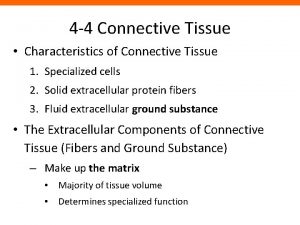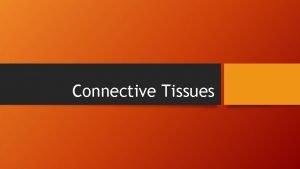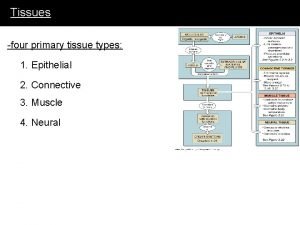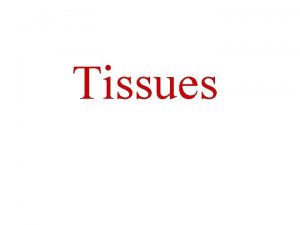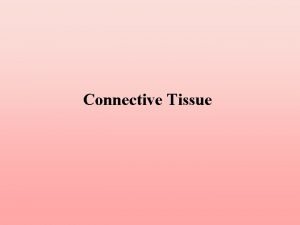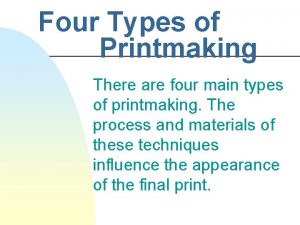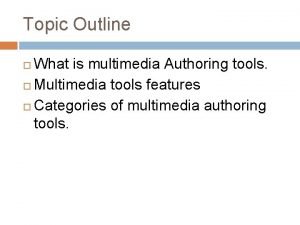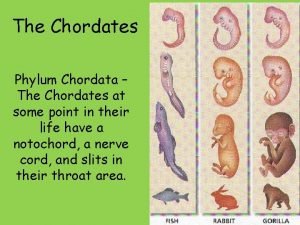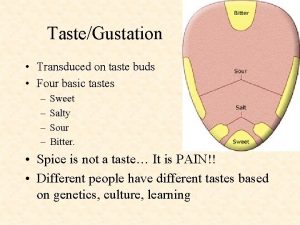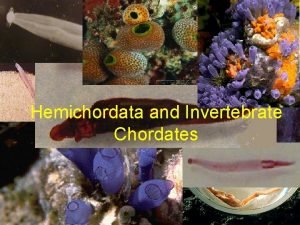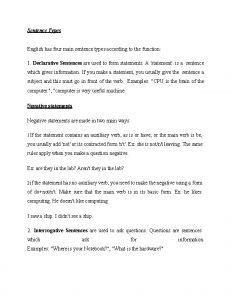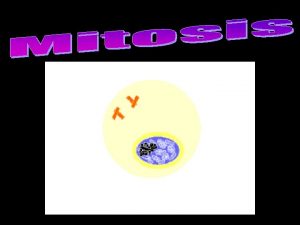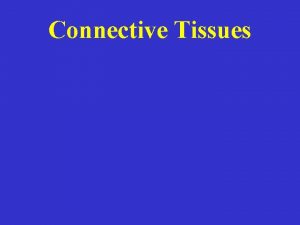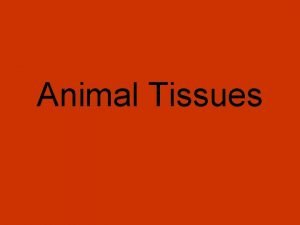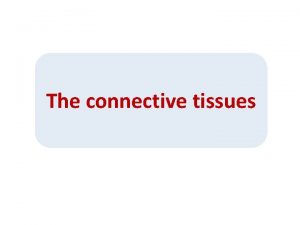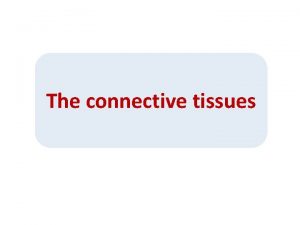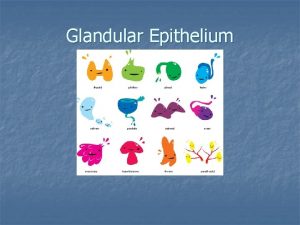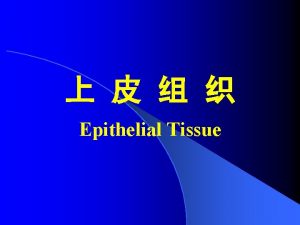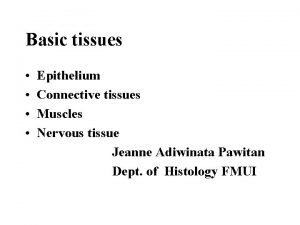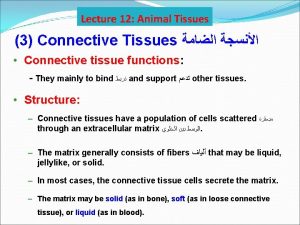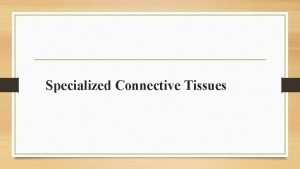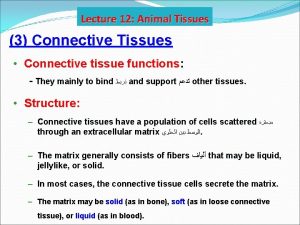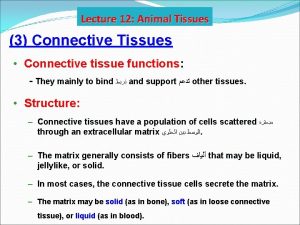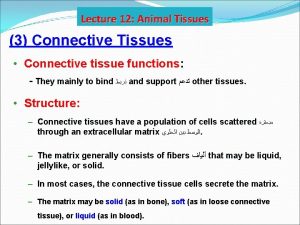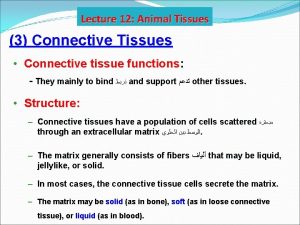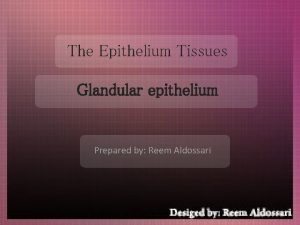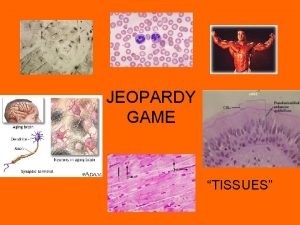Tissues Four Main Categories of Tissues Epithelium Connective









































- Slides: 41

Tissues

Four Main Categories of Tissues Epithelium Connective Muscle Nervous

Cheek Cells

Epithelial Tissue Features Divided into two categories 1. Covering/lining 2. Glandular �Arranged in continuous sheets �Single or multiple layers

Epithelial Tissue Features Tissues have: �Apical surface �Lateral surface �Basement membrane made up of mostly protein fibers

Epithelial Tissue Features �Is avascular �Has a nerve supply �Can regenerate �Cells packed tightly together

Epithelial tissue is named based on its description 1. 2. 3. 4. 5. simple = single layer stratified = multiple layers squamous = flat cuboidal = square columnar = column (rectangle)


Simple Squamous Function: Diffusion and filtration. Air sacs in lungs, walls of capillaries

Simple Cuboidal Function: Secretion and Absorption Found in: kidneys tubules, ducts and covering the ovaries

Simple Columnar Function: Secretion and Absorption Found in: Digestive tract and uterus *Contains goblet cells to secrete mucus *Can have microvilli

Stratified Squamous • Multi layer squamous cells • Function: protection • Found: In skin and mouth

Pseudostratified Columnar • Arranged in a single layer • nuclei are uneven which gives it a layered appearance • Can have goblet cells and cilia • Location: lining air passages and tubes of the reproductive system

Transitional Epithelium • Stretchable • Blocks diffusion (no leaking) • Found in the urinary bladder

Glandular Epithelium �Cells are specialized to produce and secrete substances �Glands – �Exocrine glands – secrete products into ducts �Endocrine glands – �Ex. pituitary, thyroid, adrenal

Connective Tissue � Most abundant tissue in your body Function: �Stores energy (fat) �Major transport system �Binds, protects and supports

Connective Tissue Features �Highly vascular �Except cartilage �Has nerves Consists of 1. Cells 2. Extra cellular matrix **cells vary based on the type of tissue

Types of Cells in Connective Tissue Fibroblasts �secrete protein to make fibers Macrophages �eat cell debris and bacteria Plasma Cells �secrete antibodies and attack foreign substances Mast Cells �produce histamine to prevent clots Adipocytes �store fat

1. Types of Fibers found in Connective Tissue Collagenous fibers �strong and flexible �E. x. bones, tendons and ligaments 2. Elastic fibers �very flexible �E. x. skin, blood vessel walls, lungs 3. Reticular Fibers �Provide support and strength, form stroma �E. x soft organs

Classification of Connective Tissue �Loose �Tissues are loosely arranged �Dense �Numerous thicker/denser fibers and fewer cells �Cartilage �Strong but flexible

Adipose Tissue (fat)

Lipid Nucleus of adipocyte Here is a close up of adipose tissue. You can see the large lipid containing adipocytes.

Adipocytes Here’s another view of adipose tissue.

Loose connective tissue is found in the dermis and subcutaneous layers of the skin as well as surrounding muscles. Sometimes it is called fascia.

Dense Connective Tissue • Tendons • Connect muscle to bone • Ligaments • Connect bone to bone

Cartilage • Cells are called chondrocytes • Provides support and attachments, also cushions bones

Hyaline Cartilage • Covers ends of joints, soft nose and respiratory passages (larynx and trachea)

Hyaline Cartilage Chondrocyte Lacunae � Has the characteristic chondrocyte in lacunae � “Ground glass” appearance to the matrix � Serves as a model for bone growth.

Hyaline cartilage

Another picture of hyaline cartilage. Nice “ground glass” matrix!

Elastic cartilage �Found in the external Ear and Larynx �Also has the characteristic chondrocyte in lacunae except with elastic fibers. Elastic fibers

Fibrocartilage Tough, shock absorbing

Space Race! �Go to m. socrative. com �Then enter room number 371586

Classification of Connective Tissue (Continued) �Bone �Protects, allow movement, produces necessary materials �Liquid Connective Tissue �Blood �Lymph

Muscle Tissue Function: movement and generate heat Types of Muscle Tissue: �Skeletal �Movement of bone �Smooth �Organ movement �Cardiac �Form wall of the heart

Nervous Tissue Made up of: �Neurons �Sense and respond to stimuli �Neuroglia �Protective and supportive functions

Tissue Repair �The replacement of dead or worn out cells �New cells are created through cell division from three locations �Stroma �Supporting connective tissues �parenchyma

Renewal Capacity Continuous renewal �Epithelial tissue �Some types of connective tissue �Bone vs Cartilage Poor capacity �Muscle tissue �Nervous tissue

The Stem Cell Debate 1. How far should researchers take stem cell technologies? Just because we can do something, should we? Why or why not? 2. Do embryonic stem cells represent a human life? This is an ongoing debate that brings up the question of when life begins. Should the embryo or fetus have any rights in the matter? Who has the authority to decide?

Parenchymal Cells vs Fibroblasts �Regeneration is possible if parenchymal cells do the repair �Why? �If fibroblasts do the repair the injured tissue is replaced with connective tissue �Scars form �Results in impairment of original tissue function

Aging and Tissues �Younger cells have a better blood supply and are in a better nutritional state �Glucose and aging �Elastin and aging
 Types of tissue in the body
Types of tissue in the body Body tissues chapter 3 cells and tissues
Body tissues chapter 3 cells and tissues Body tissues chapter 3 cells and tissues
Body tissues chapter 3 cells and tissues Cells form tissues. tissues form __________.
Cells form tissues. tissues form __________. Anatomy chapter 3 cells and tissues
Anatomy chapter 3 cells and tissues What are specialized connective tissue
What are specialized connective tissue Characteristics of connective tissues
Characteristics of connective tissues Components of dense connective tissue
Components of dense connective tissue What do all connective tissues have in common
What do all connective tissues have in common Cutaneous membrane
Cutaneous membrane Four major tissue types
Four major tissue types Hyaline cartilage location
Hyaline cartilage location Four basic tissues
Four basic tissues Main connective
Main connective Two main categories of software
Two main categories of software 4 components of system software
4 components of system software Main categories of software
Main categories of software What are the two main categories of ecosystems
What are the two main categories of ecosystems What are the four noncompeting categories of labor
What are the four noncompeting categories of labor Printmaking types
Printmaking types Introduction to service marketing
Introduction to service marketing Future time will and going to
Future time will and going to Main ideas examples
Main ideas examples Void main int main
Void main int main Structure of a fern
Structure of a fern Four main groups of plants
Four main groups of plants What are the four main attributes of professional image
What are the four main attributes of professional image Four main components for effective outlines
Four main components for effective outlines What are the four main features of technical communication
What are the four main features of technical communication Icon based authoring tools example
Icon based authoring tools example Alligator phylum and symmetry
Alligator phylum and symmetry Four basic tastes
Four basic tastes What are the four main characteristics of chordates
What are the four main characteristics of chordates Four main goals of psychology
Four main goals of psychology Multimedia development tools
Multimedia development tools Whmis hazard categories 1-4
Whmis hazard categories 1-4 Four main sentence types
Four main sentence types Parts of a folktale
Parts of a folktale What are the literary elements of a folktale
What are the literary elements of a folktale Describe
Describe Brain parts and functions
Brain parts and functions Stages of the cell cycle diagram
Stages of the cell cycle diagram






